Dahabiya: Sailing the Nile, Past and Present
Kenzy Fahmy
For thousands of years, the Nile, with its tranquil and slow moving water, has provided the Egyptians with an ideal form of transport. Sailboats, barges and skiffs have been traveling the dark river since ancient times, carrying people and goods from one part of the country to another along the watery highway at a time when traveling long distances on land was incredibly difficult. For most people it was virtually impossible. The Nile, Egypt’s backbone and lifeblood, was not just a source of life but a connection between this world and the other. It was what kept life going, year after year, flood after flood. It is what helped the ancient Egyptians flourish and become the immensely successful civilization that we see traces of on every face and facet of the country.
Today, it is manmade highways that carry our people and goods from one place to another, but the sailboats of the past still remain. In Cairo, and in Aswan, white-sailed feluccas glide quietly through the city, detached from the hectic rhythm of life on land, the humble descendants of their ancient ancestors. Much like the felucca, dahabiyas too are a remnant of our past. The name dahabiya, from the Arabic dahab, means golden one. Perhaps this is a nod to their ability to travel past the southern Nile cataracts and into Sudan, or Nubia or Kush depending how far back we go, into the land of gold.
During the 19th century, travel had become more accessible and, following the French expedition to Egypt, Europe’s obsession with the exotic East was entering into full swing and a wave of Egyptomania was quickly sweeping over the continent. During the first half of the century travel was still mostly limited to academics, artists and explorers whose goal was to uncover and document the country’s many hidden secrets. At the time, most of her ancient heritage was still buried under sand or water. This was the golden era of archaeology – and Orientalism - and everyone wanted a piece of ancient Egyptian history, everyone wanted their own name to go down in history as one of the great discoverers.
Up until the late-19th century, the only way to travel on the Nile was on a dahabiya, which at the time was closer to a houseboat or a felucca, and a trip from Cairo to Aswan would normally take months. It was an arduous journey undertaken by men and women driven by obsession, a thirst for adventure, and a quest for greatness. They were in search of glory. Over time, the dahabiyas became more and more luxurious and were used more and more by the world’s elite, including royal families, both local and foreign. Fouad, Farouk, Nasser and Sadat reportedly all had their own private dahabiya, with some boats being passed from the hands of one ruler to the next.
These small vessels were specially designed to be used on the Nile, with a double mast and flat bottom that helped them navigate the cataracts and other rocky areas with ease. Over time they were fitted with comfortable cabins that were beautifully decorated and had everything one would need for a long cruise. A small number of these historic boats are still in use.
Figures like the Italian explorer, Giovanni Belzoni, French author, Gustave Flaubert and even the famous nurse and statistician, Florence Nightingale, were among those who travelled on the traditional dahabiyas, creating descriptions of their journeys and experiences that would inspire travellers for decades to come. These trips, while dominated by male travellers, were also undertaken by handful of women who sought to expand their world and escape the monotony of life in Europe.
By the 1870s, steamer ships had begun to be introduced and a trip that would have taken months now took only weeks. Thomas Cook, who had already been operating dahabiyas at the time, was one of the first to introduce the steamer to the Nile, and with it, a new kind of tourist. One could easily argue that here lay the birth of modern tourism. The age of exploration was rapidly coming to an end, and the time of the casual tourist would begin. Eventually, the large diesel-powered boats of today would become the standard option for Nile cruises, with space for far larger groups of people and the option to cut the trip down to mere days.
But the 21st century saw a revival of the dahabiya. People once again wanted to sail down the Nile in a traditional wind-powered vessel, gliding silently over the water, allowing them to take in the stunning natural beauty of the river banks while moving from one archaeological site to another. The boats themselves are almost always designed and decorated in a way that evokes the charm and beauty of their 19th century counterparts. Many are filled and furnished with genuine 19th century antiques, pieces taken from old homes, hotels and decommissioned boats. Some have even restored old dahabiyas, fitting them with a few modern luxuries while staying true to their original form. Until today, dahabiyas come with no engine. They rely on the wind to travel south and river currents to travel north, just as the ancients did. Today though, if neither is available a small tugboat pulls them along.
Dahabiyas are as popular, and exclusive, as ever. Like windswept capsules of time, they provide a glimpse into what life and travel was like more than a century ago, and offer something that is often hard to come by in our modern world; silence. A more authentic way of exploring the heritage and history of the Nile would be hard to find.





